We were once again in Baden-Württemberg and explored a region unknown to us: Upper Swabia-Allgäu. Nestled between Lake Constance, the foothills of the Swabian Alb, and the Allgäu Alps, this region awaited us with charming towns, idyllic natural highlights, magnificent castles, churches and monasteries, as well as regional delicacies.
Our round trip took us from Kißlegg to Ravensburg via Weingarten, Bad Waldsee, Biberach, Sigmaringen, and Bad Buchau. In the following article, we’ll introduce you to the route and our trip highlights. Enjoy browsing!
- Overview of the Upper Swabia-Allgäu Round Trip
- 1. Kißlegg & Kißlegg Lake District
- 2. Don’t miss: Ravensburg
- 3. Weingarten & Stiller Bach
- 4. The gem of Bad Waldsee
- 5. Upper Swabian Museum Village Kürnbach
- 6. Federseesteg in Bad Buchau
- 7. The monastery town of Bad Schussenried
- 8. The eye-catcher Biberach
- 9. Sigmaringen & Hohenzollern Castle
- Our hotel tips
- Conclusion of the tour through Upper Swabia-Allgäu
Overview of the tour through Upper Swabia-Allgäu
Our 5-day tour through Upper Swabia-Allgäu started in Kißlegg. From there we continued to Ravensburg, Weingarten, Bad Waldsee, Bad Schussenried, Bad Buchau, Biberach, and Sigmaringen. We recommend at least 5 full days for this trip to explore the places mentioned.
Our route at a glance:
- Kißlegg & Kißlegger Seenplatte
- Ravensburg
- Weingarten & Stiller Bach
- Bad Waldsee
- Upper Swabian Museum Village Kürnbach
- Monastery Town of Bad Schussenried
- Federseesteg & Federseemuseum Bad Buchau
- Biberach an der Riß
- Sigmaringen & Hihenzollernschloss
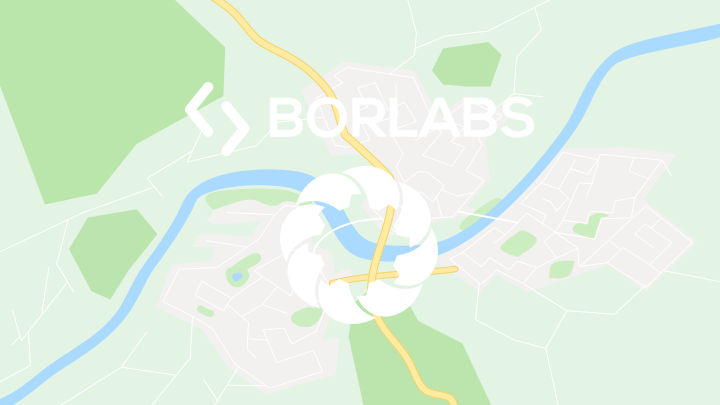
By loading the map, you accept Google’s privacy policy.
Learn more
Load map
1. Kißlegg & Kißlegg Lake District
Our Upper Swabia-Allgäu tour began in the small town of Kißlegg, located about 25 kilometers southwest of Ravensburg and near the Bavarian border. Since the surrounding area is characterized by forests, hills, and lakes, a hike in the so-called “Kißlegg Lake District” was a good idea. The almost 8 km long circular trail led us from Immenried past the Holzmühle, Langwuhr, Hasen, and Brunner Weiher lakes (☞ click here for the hiking route).
Afterwards, we strolled through Kißlegg and visited the New Palace with its palace gardens, the Old Palace, and the beautiful Parish Church of St. Gallus and Ulrich. Be sure to take a look inside. This impressive Baroque church is known for its magnificent interior. To round off our visit, we treated ourselves to an ice cream sundae at the Dolomiti Eiscafé.
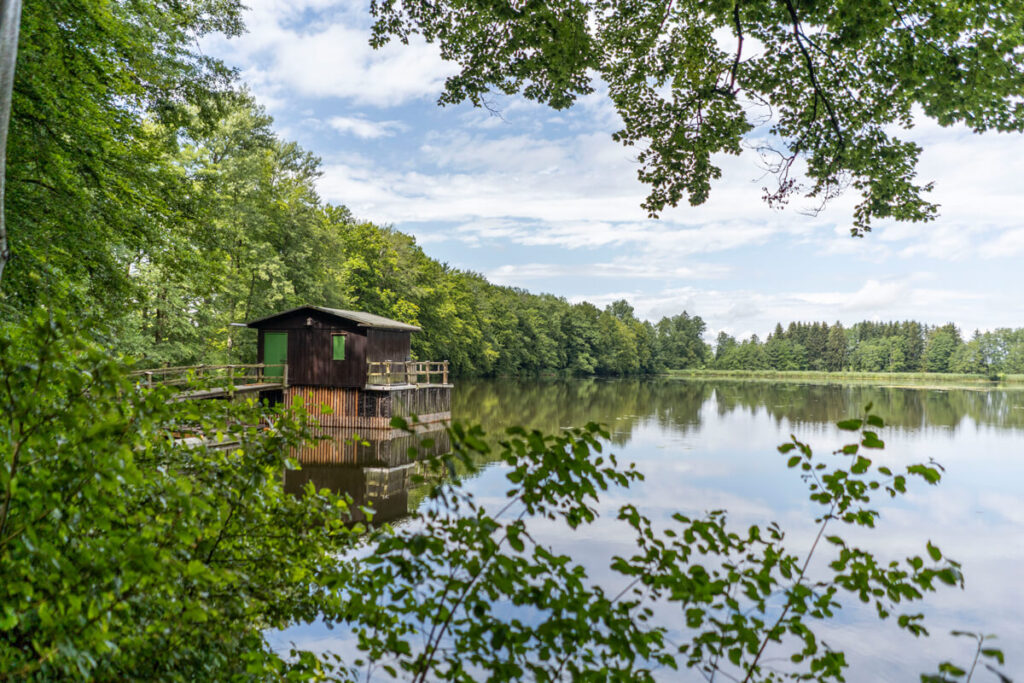
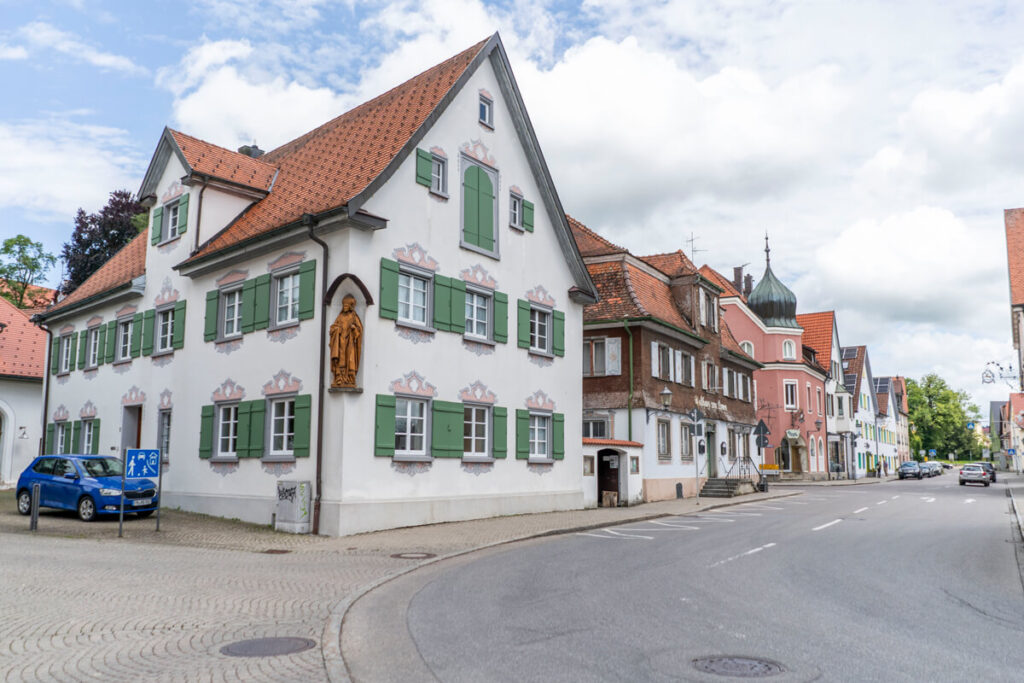
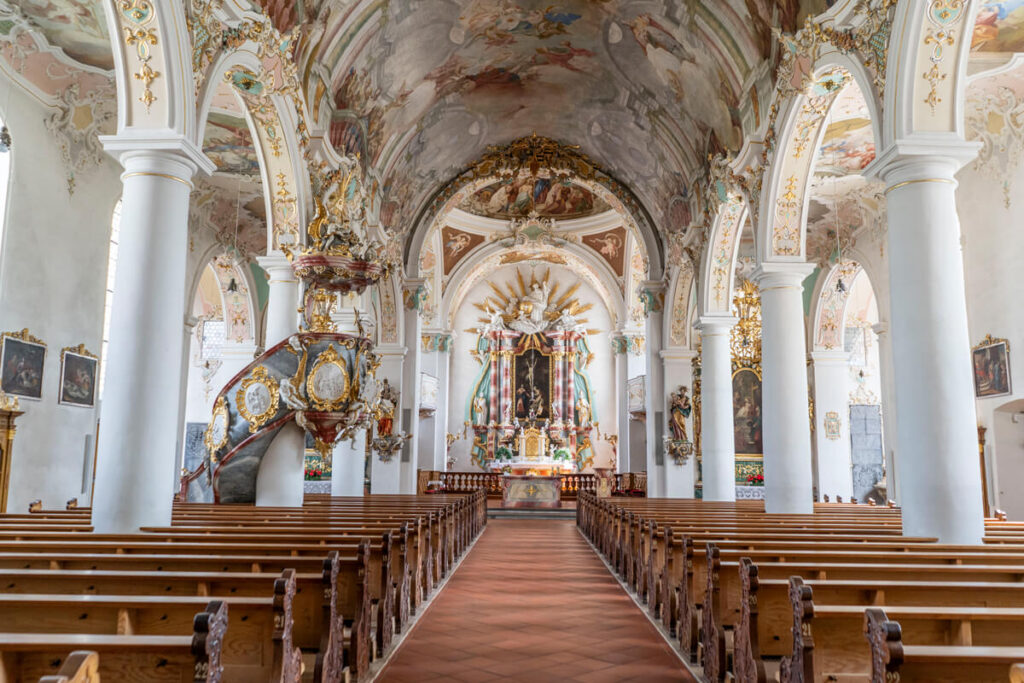
2. Don’t miss: Ravensburg
A highlight for us in the Upper Swabia-Allgäu region was a visit to the city of Ravensburg. The “City of Towers and Gates” was founded in the 11th century and is located about 20 kilometers north of Lake Constance. Many people naturally associate Ravensburg with the company “Ravensburger,” which has its headquarters in Ravensburg and produces board games and puzzles.
And on a stroll through the beautiful old town, you’ll not only discover the company’s oversized blue game pieces and the Ravensburger Museum, but also great sights, such as the town hall, Marienplatz, the Humpis Quarter, or Bachstrasse, with its beautiful half-timbered houses.
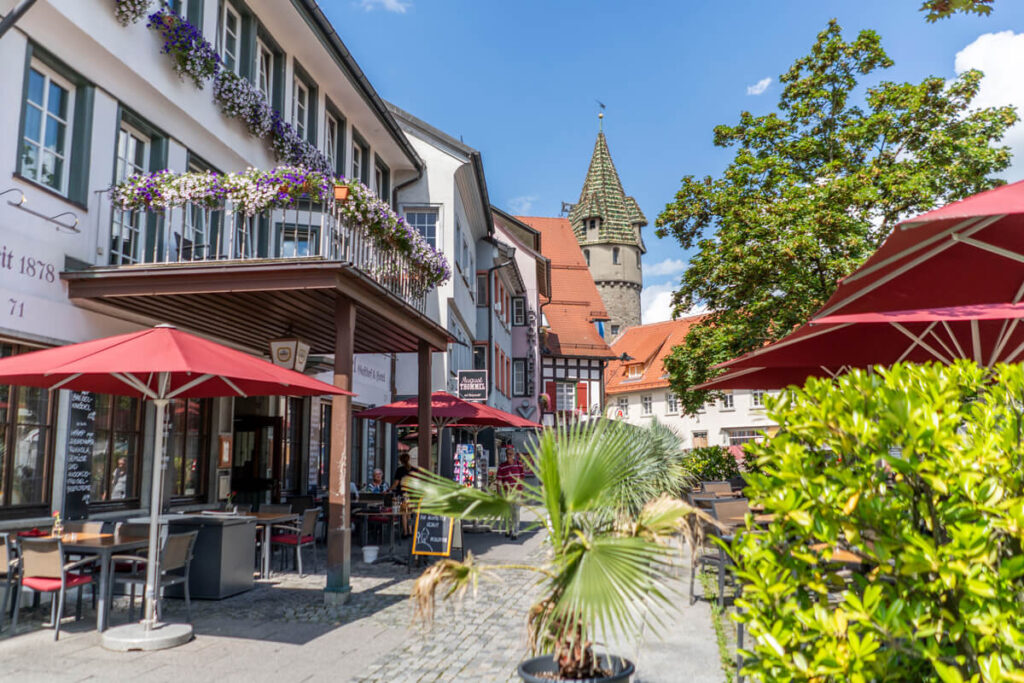
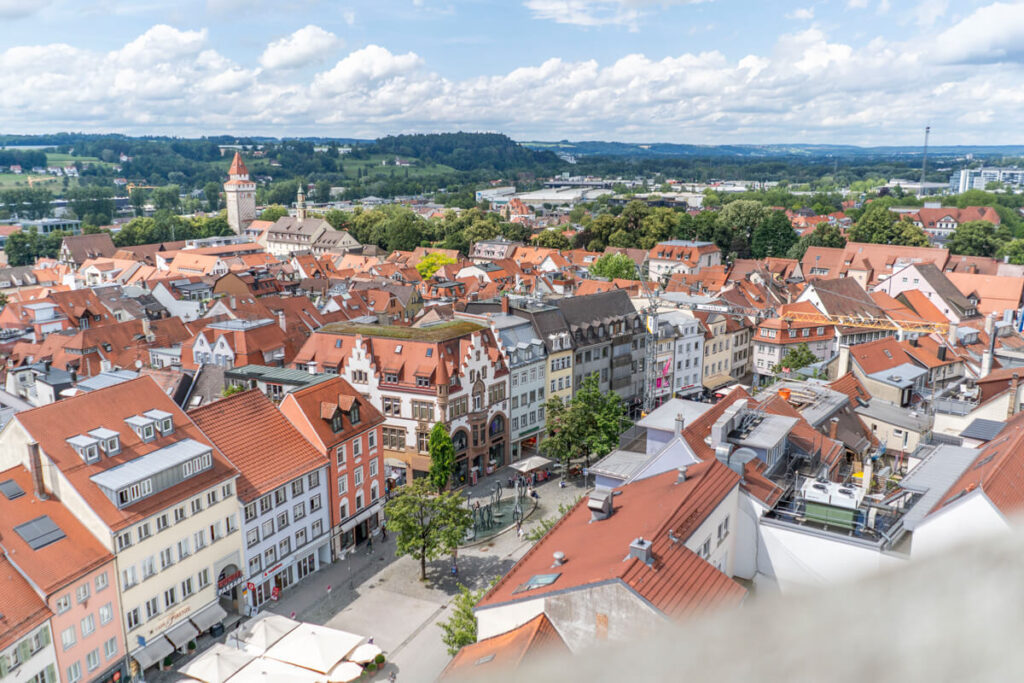
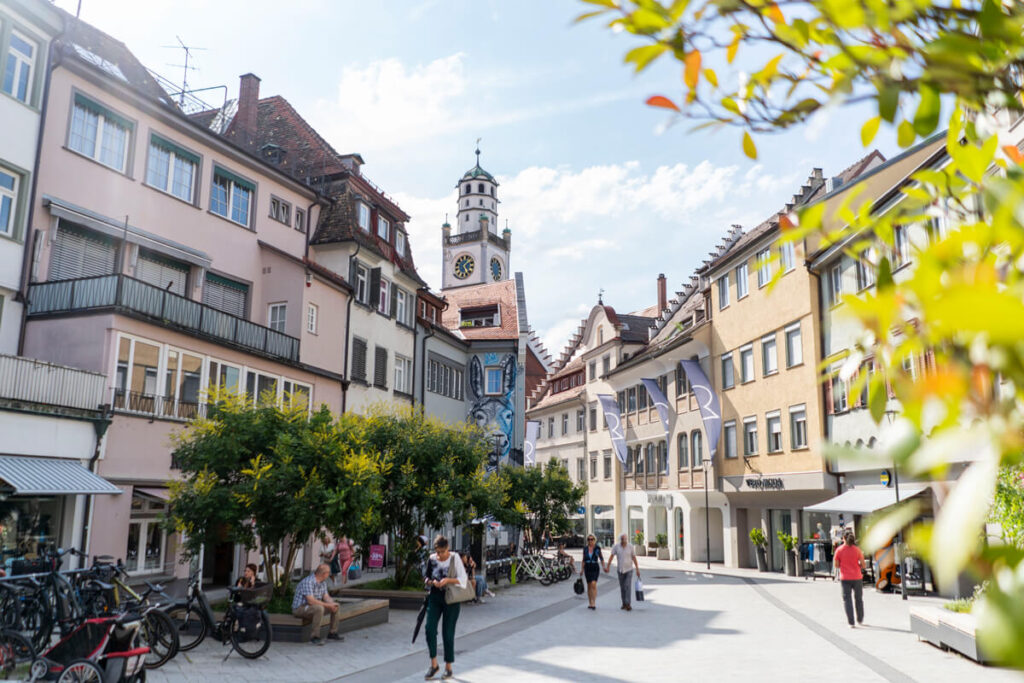
One of the top highlights is definitely the view from the 51-meter-high Blaserturm. For just €3.50, you can climb the tower and enjoy the view over the rooftops of the old town. Just above the old town is the Veitsburg, from where you also have a beautiful view of Ravensburg (especially at sunrise and sunset).
The old town also has numerous fountains, museums, restaurants, cafés, and shops. With the Ravensburg GO app you can explore the city in a playful way (☞ Apple Store | ☞ Google Play Store). The more sights you discover and puzzles you solve, the more points you can collect. You can then redeem these points for discounts at shops, restaurants, and leisure facilities.
Our food tips for Ravensburg:
- Zwölf87
- PANO – Bread & Coffee
- Restaurant Colours Ravensburg
- nero espresso.food.lifestyle.
- CAFÉSITO Coffee Roastery Ravensburg
- Restaurant Kupferle
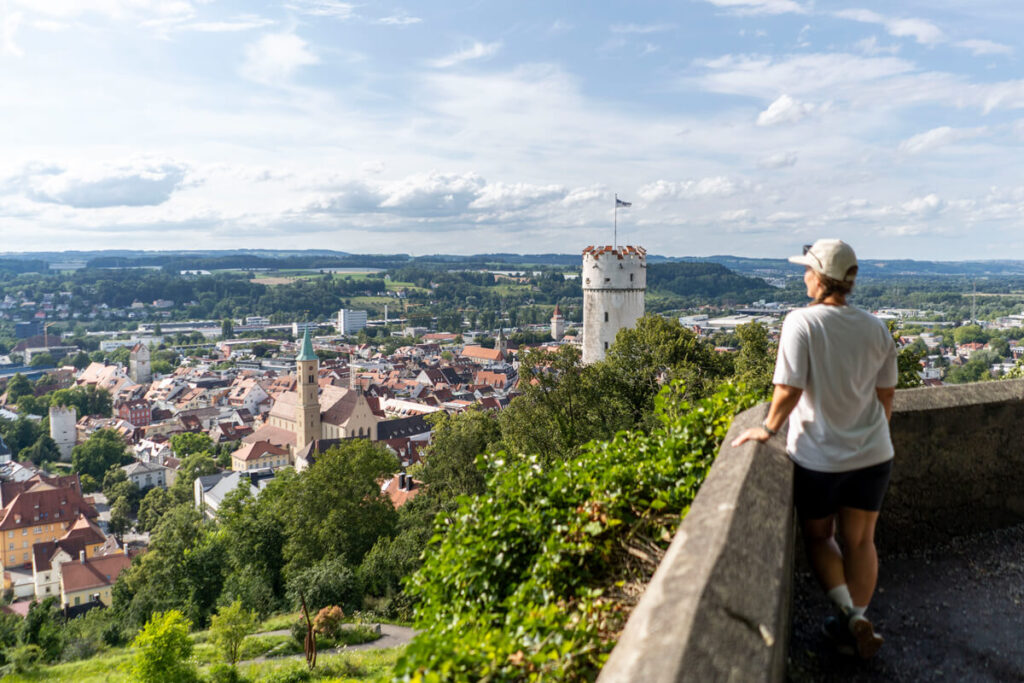
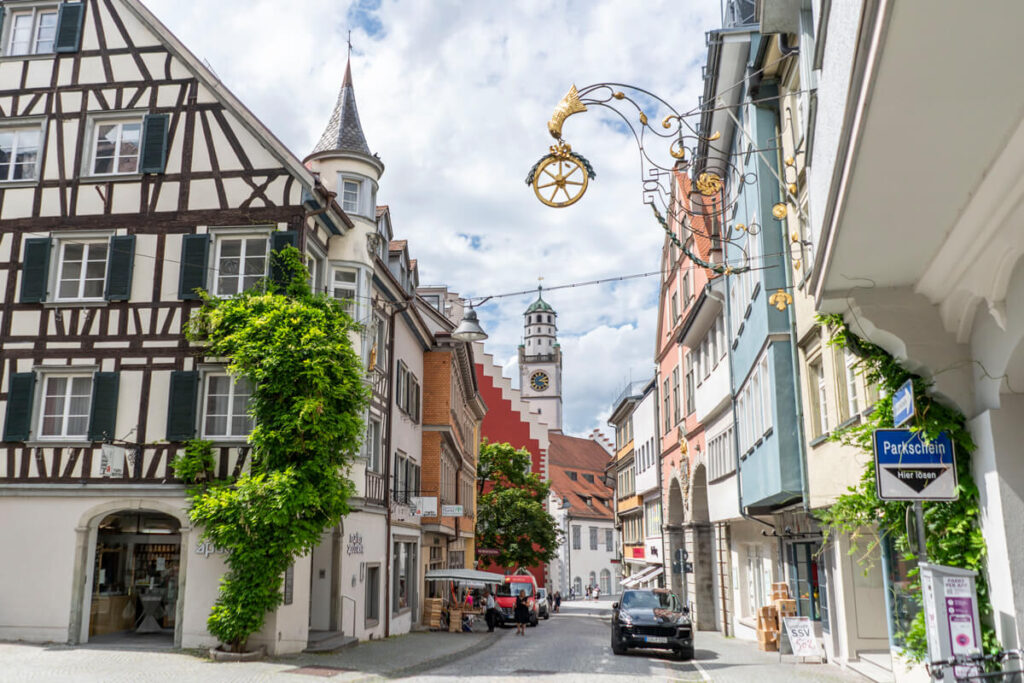
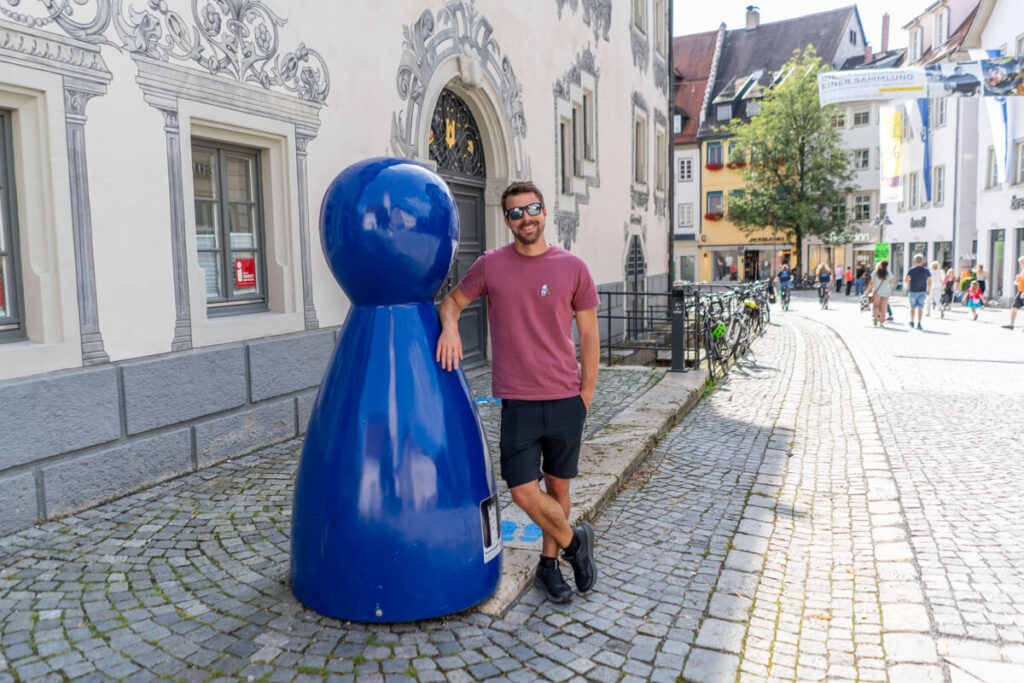
3. Weingarten & Stiller Bach
Right next to Ravensburg is the town of Weingarten, with a population of 23,000, which is the third largest town in the Ravensburg district after Wangen im Allgäu. The town has a long history dating back to the Middle Ages. The name Weingarten is derived from the former Benedictine monastery founded here in the 11th century.
In Weingarten, one of the largest Baroque churches north of the Alps towers high above the town’s rooftops. It is known for its imposing architecture and impressive interior. A visit should not be missing from your itinerary. Afterwards, you can take a stroll through the small old town.
Also worth seeing is the historic water system “Stiller Bach”. This underground canal system was built in the Middle Ages and served to supply water to the monastery and the town of Weingarten. During a nearly 6 km circular hike, you can see one of the “oldest non-Roman canal systems north of the Alps” and simultaneously enjoy the idyllic surrounding nature (☞ click here for the hiking route).
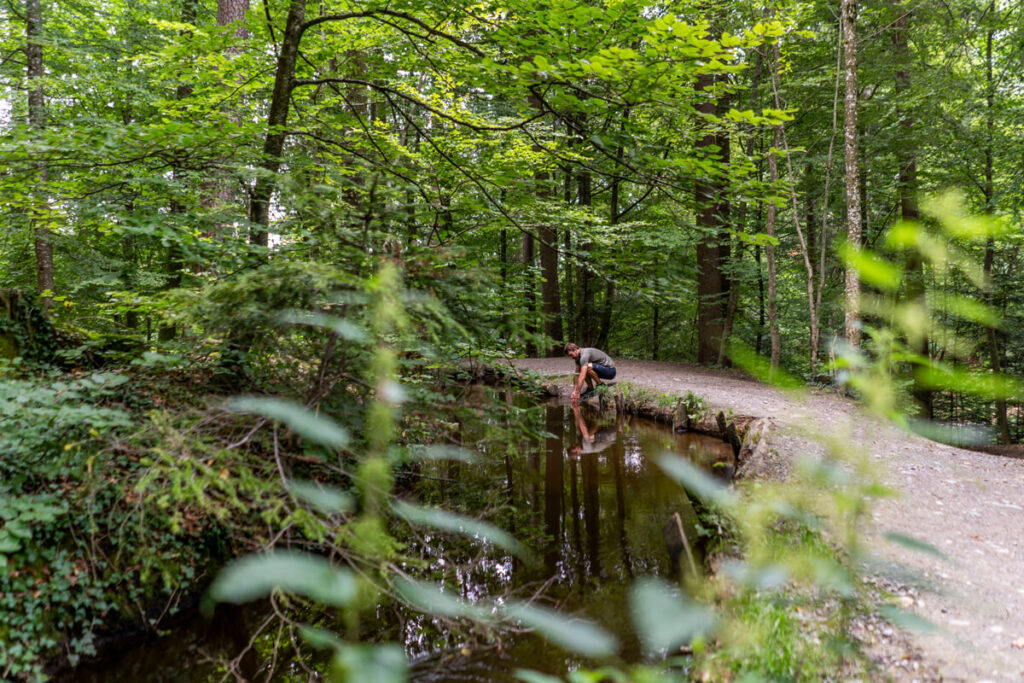

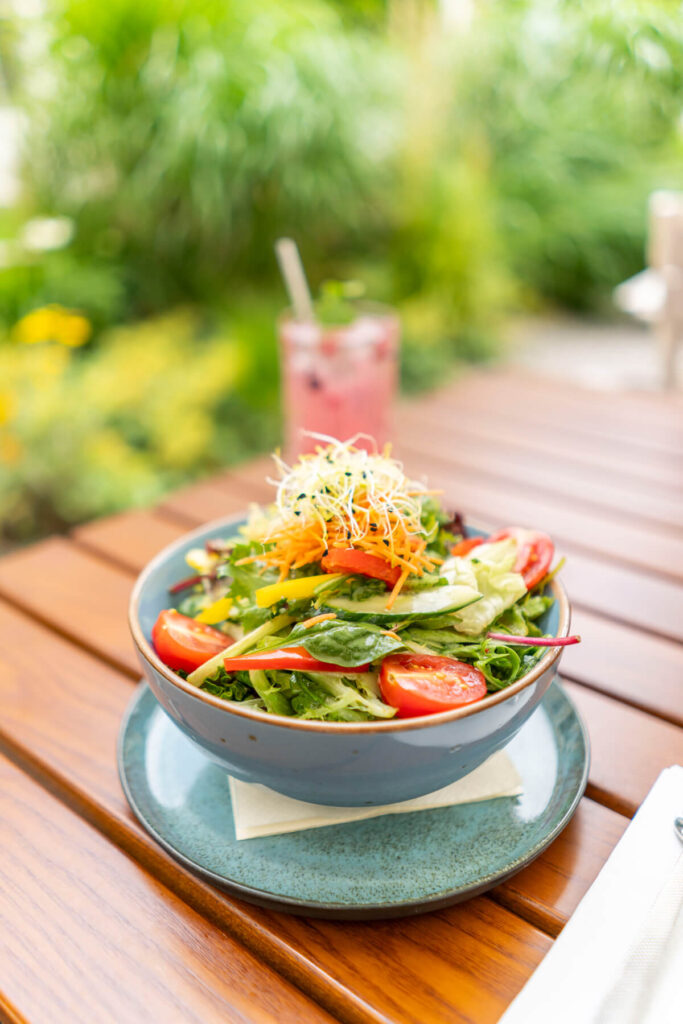
4. Gem of Bad Waldsee
Our road trip now took us further to the enchanting town of Bad Waldsee. The town is located in the Upper Swabian hills between Lake Constance and the Swabian Alb and has a population of around 20,000. Above all, the picturesque location between two lakes makes Bad Waldsee a truly wonderful place to relax. These lakes offer various opportunities for walking, boating, picnicking, swimming, and fishing.
Be sure to take your time and stroll through the historic Old Town, where you can discover well-preserved half-timbered houses, narrow streets, and historic buildings. Worth seeing are, among others, the Kornhaus, the Town Hall, the Wurzach Gate, and the Holy Spirit Hospital. Not to be forgotten is the impressive parish church of St. Peter from the 14th century.
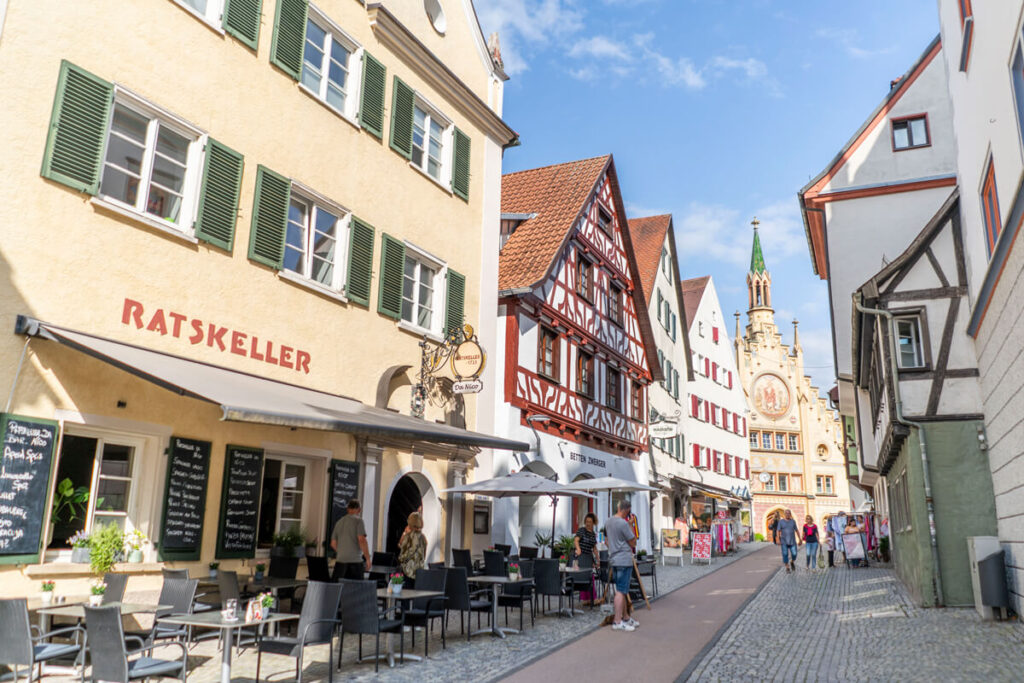
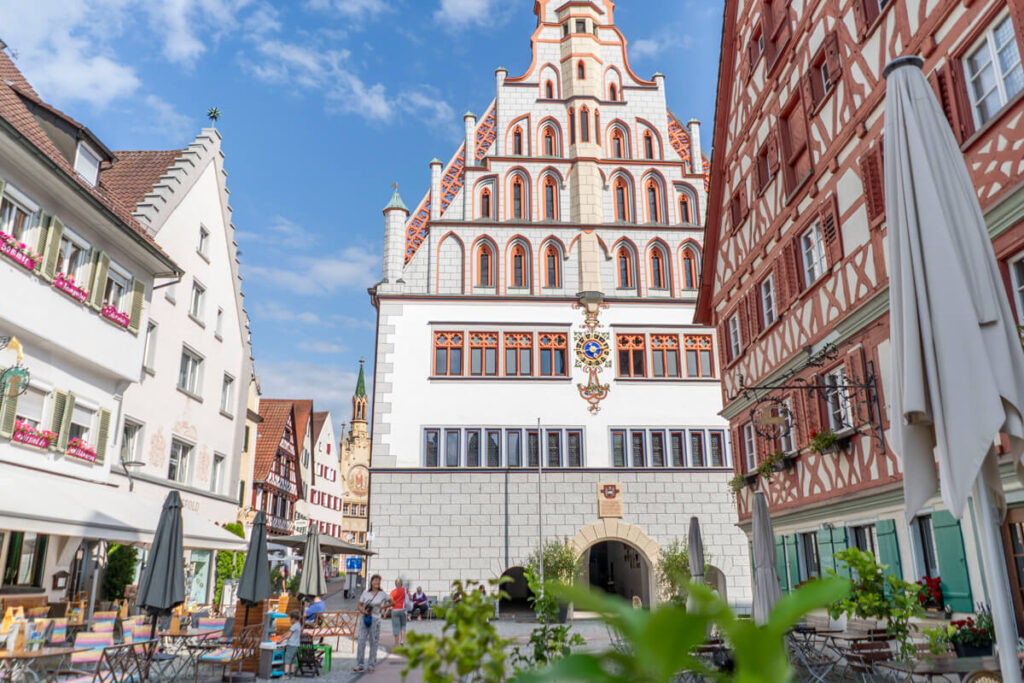
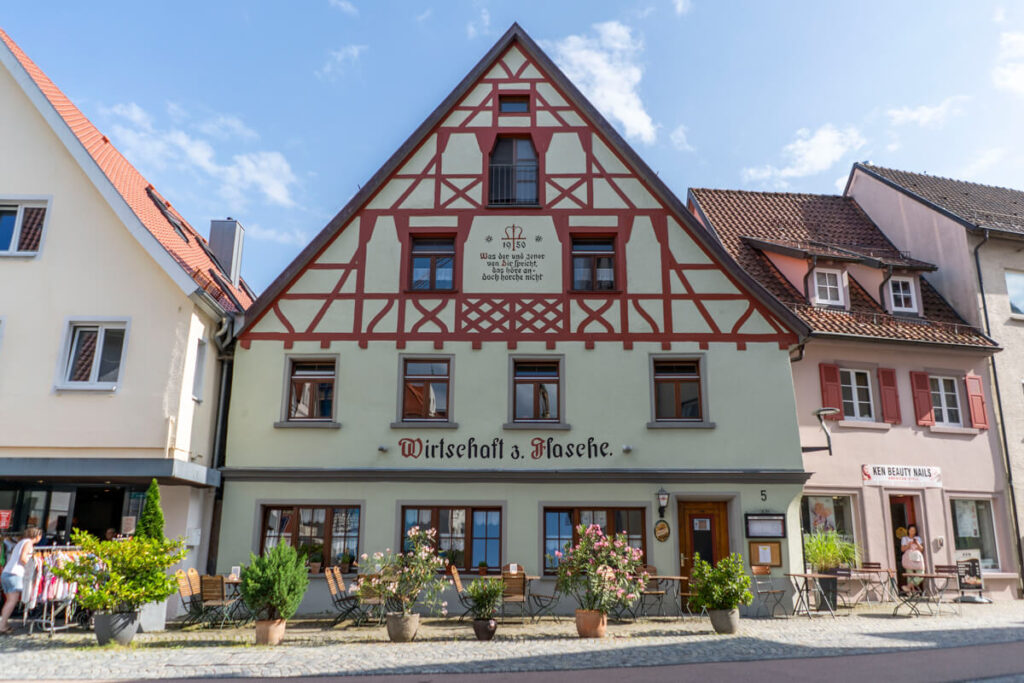
We recommend a leisurely stroll around the town lake. From the other side of the lake, you have a fantastic view of the old town. Right on the shore of the town lake, you can also rent a rowboat or pedal boat for a few euros and explore the lake and enjoy the view from the water. We did it and found it very helpful! Bad Waldsee is a wonderful place to “recharge your batteries” in many different ways.
Our food tips for Bad Waldsee:
- Hotel Restaurant Grüner Baum
- Scala Restaurant am Stadtsee
- Ristorante Pizzeria Gusto
- Cafézeit im Hecht
- Mr.Ha Bad Waldsee
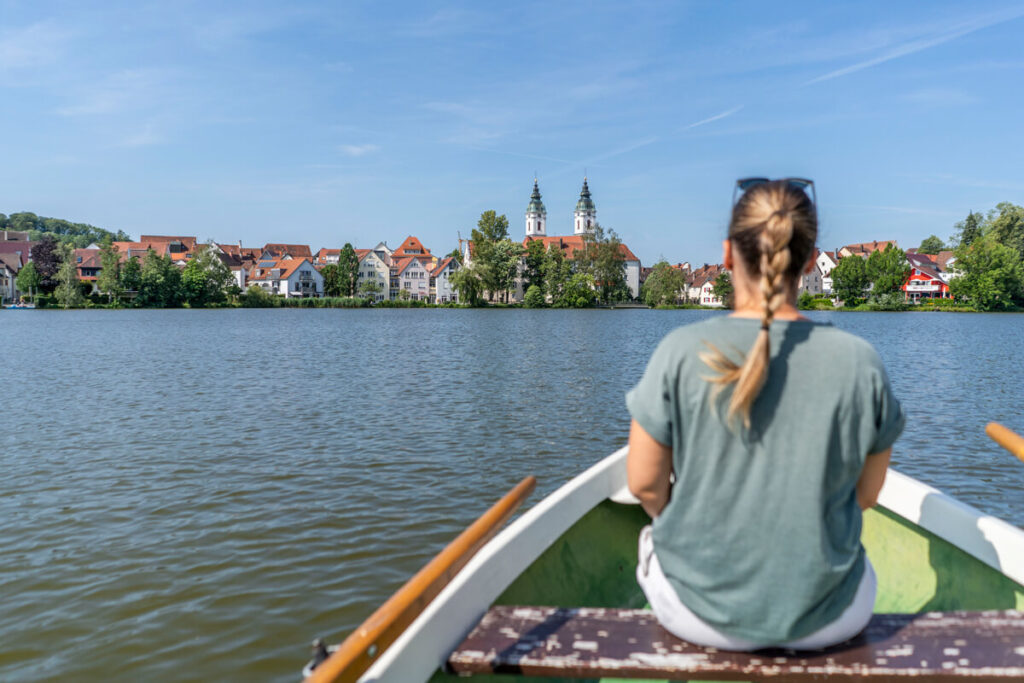
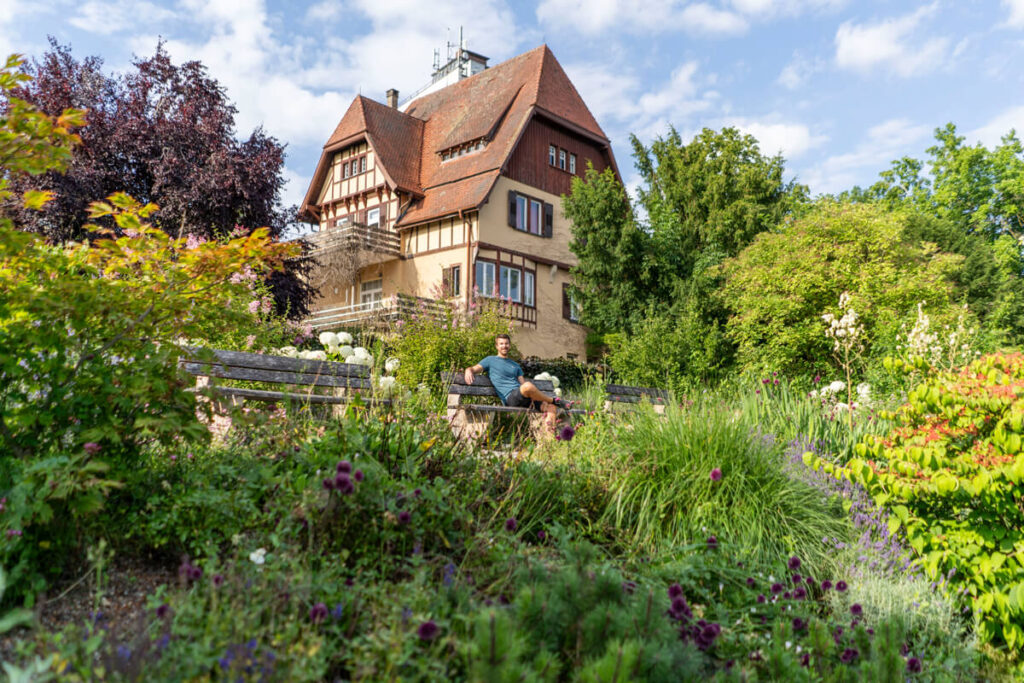
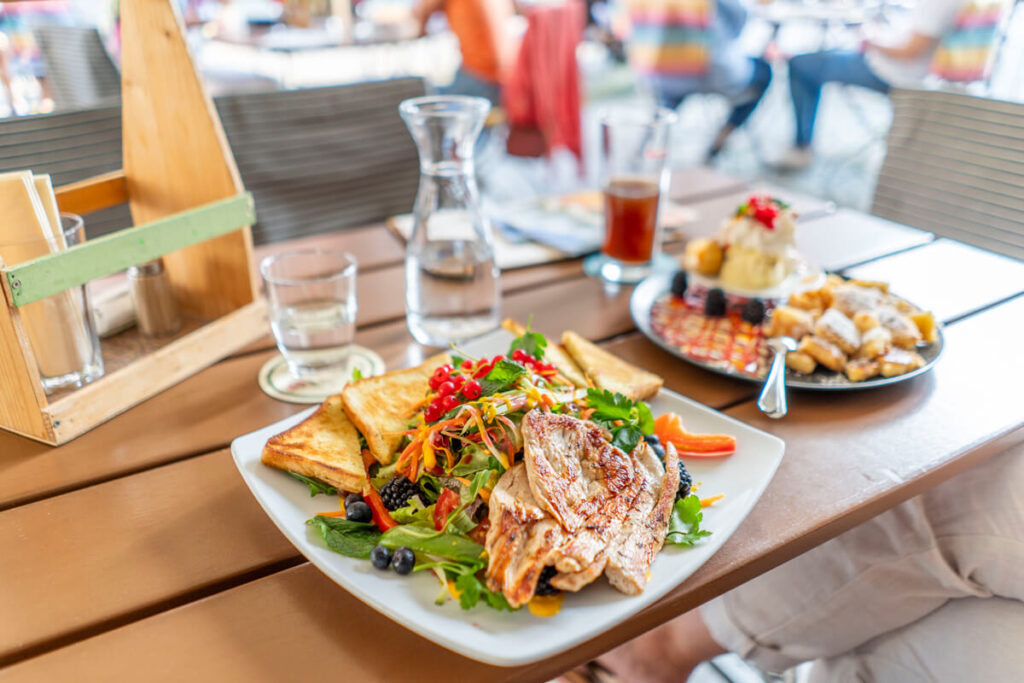
5. Upper Swabian Museum Village Kürnbach
We have to admit that we’re not the most ambitious museum-goers. However, the Upper Swabian Museum Village Kürnbach is a very important open-air museum that offers a comprehensive insight into rural life in the Upper Swabia region from the 16th to the 20th century. Over 40 historic buildings are located on the grounds, including originally furnished workshops and living rooms. These were relocated from various parts of Upper Swabia to the museum village and faithfully reconstructed. Each building represents a different architectural style and standard of living from the region and the respective time period. Between the buildings, you will repeatedly discover idyllic farm gardens and orchards.
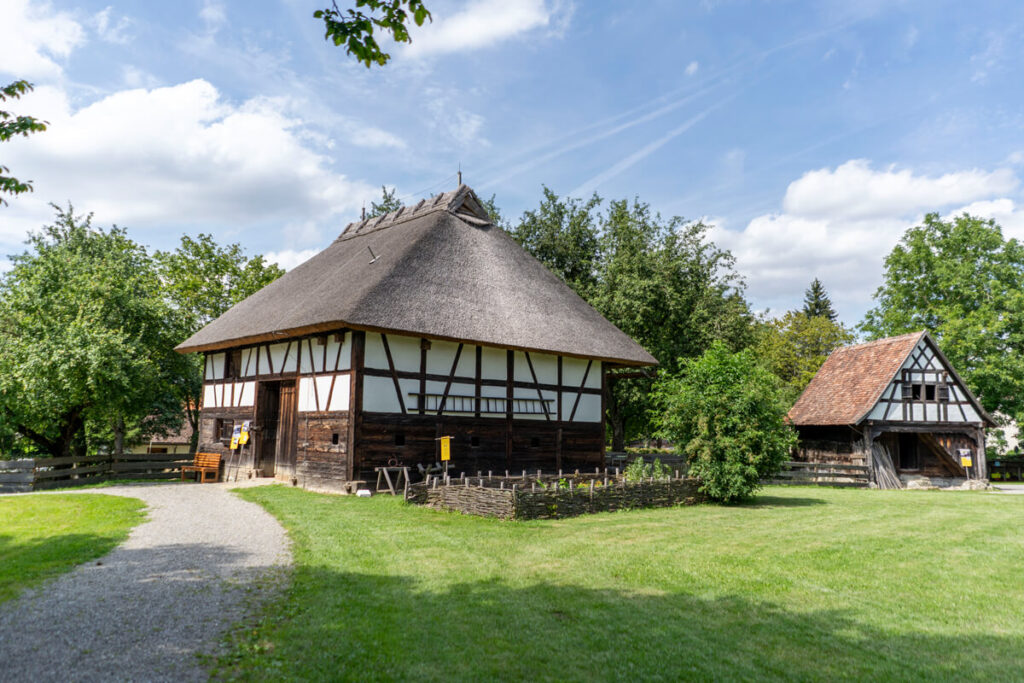
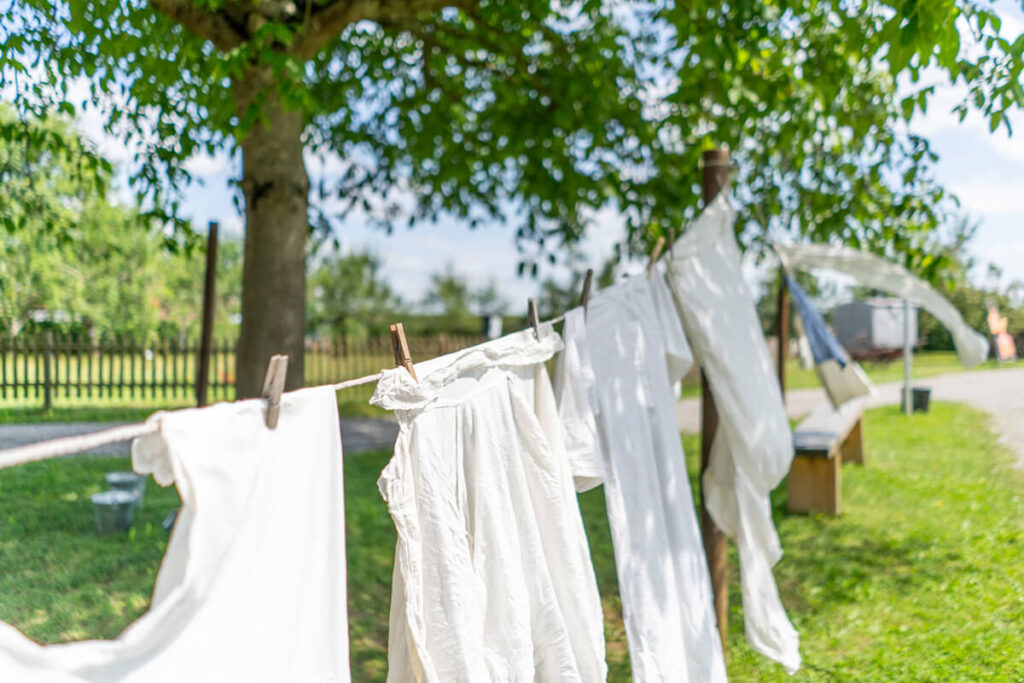
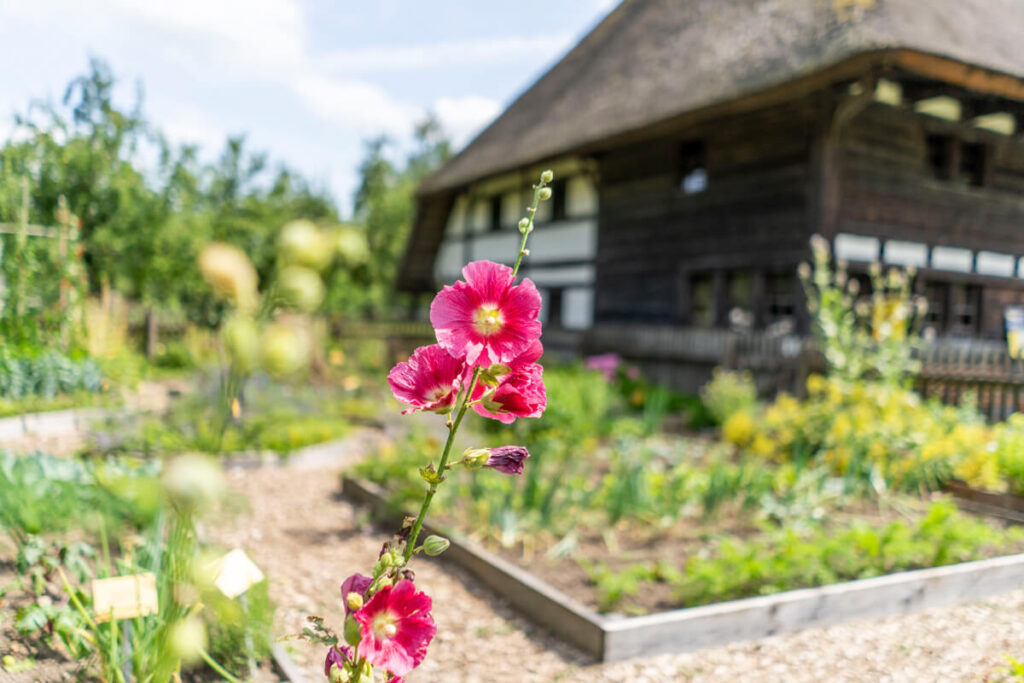
The area also offers plenty of variety for children (tree house, animal enclosure, hands-on activities and much more). There are also various events where children and parents can try out old crafts or do handicrafts together. So if you want to see how people lived and worked in the past, you’ve come to the right place.
Speaking of work, we took part in a “wash day” and experienced firsthand how people used to wash and dry their laundry. It was quite strenuous and involved a lot of effort. We can only be glad that the washing machine does most of the work these days.
Visitor Information Museum Village:
- Address: Griesweg 30, 88427 Bad Schussenried
- Opening Hours: March 24 to November 3, 2024, open daily from 10 a.m. to 6 p.m.
- Admission Prices: Adults €7.50, Concessions €6, Children (3-17 years) €3.50
- Events: for events and special days

6. Federseesteg in Bad Buchau
From the museum village in Kürnbach, we continued on to a very special natural highlight: the Federseesteg in Bad Buchau. This footbridge leads through one of the largest contiguous moorland areas in southwest Germany. It stretches for about 1.5 kilometers and takes you from the edge of Lake Federsee through the dense reed landscape to a viewing platform directly on the lake.
Lake Federsee is an important nature reserve and part of the UNESCO World Heritage Site “Prehistoric Pile Dwellings around the Alps.” The area surrounding the lake is characterized by moors, reed beds, and wet meadows, providing a habitat for many rare animal and plant species. The bridge allows you to experience the fascinating moor and lake landscape up close without disturbing the sensitive ecosystem.
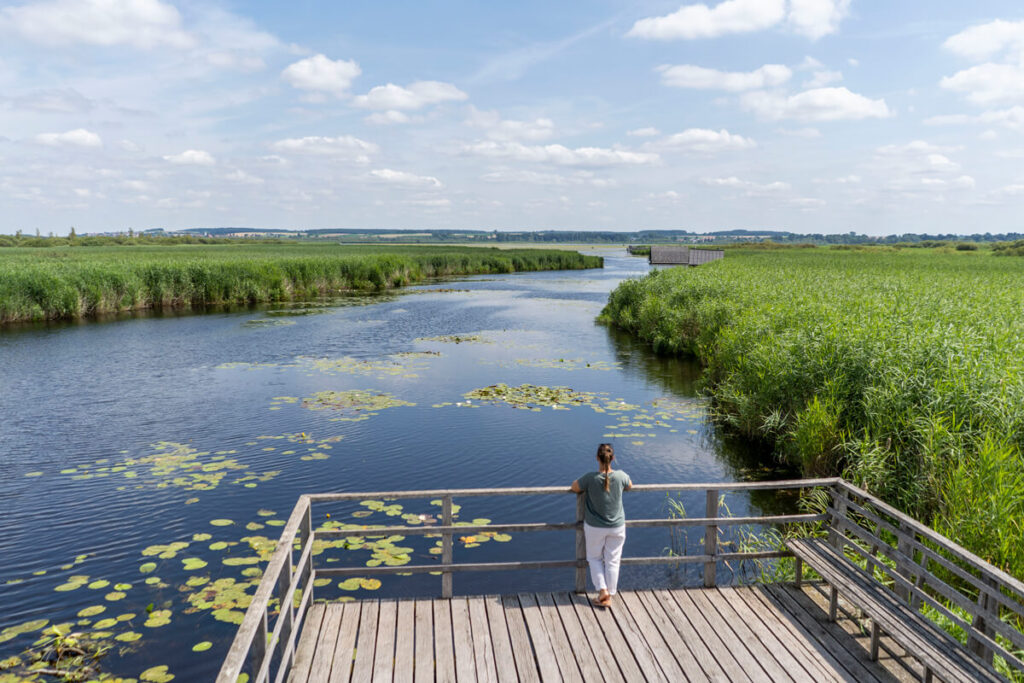
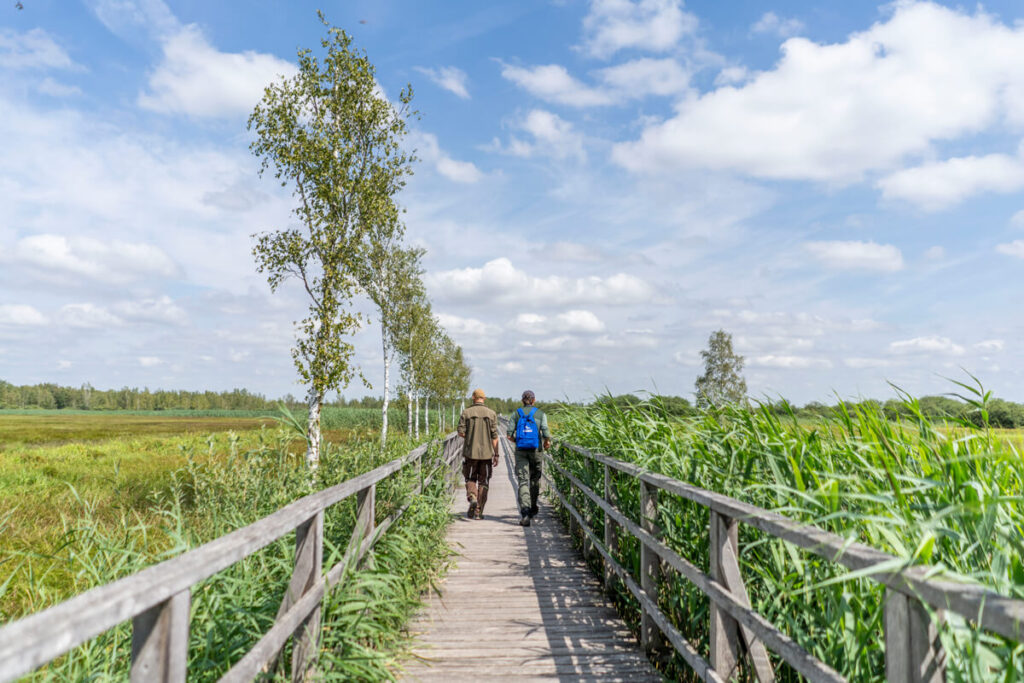
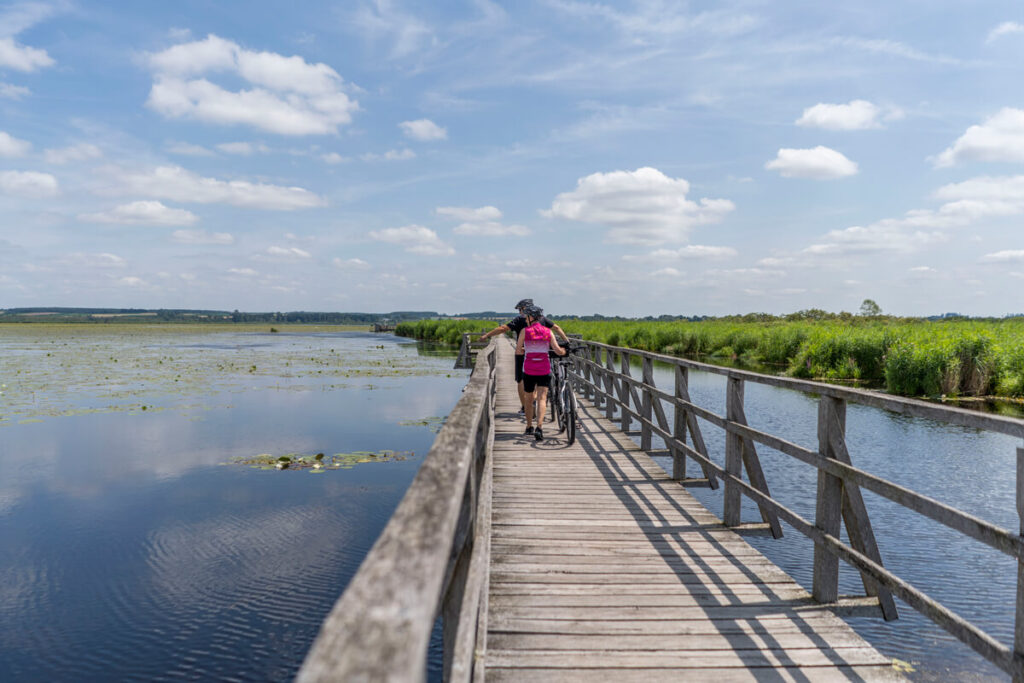
Are you also interested in wildlife? Lake Federsee is a paradise for birdwatchers. Over 270 bird species have been recorded here, including rare species such as the bearded reedcock, curlew, and various duck species. The pier offers numerous observation points from which you can observe the birds in peace, especially during migration in spring and autumn. Don’t forget your binoculars!
Be sure to also take a detour to the Federseemuseum. The museum combines original finds with authentic reconstructions in the open air and showcases the lifestyles of Ice Age hunters, pile dwellers, and Celts. Thanks to the special preservation in the Federsee Moor, 15,000-year-old finds offer unique insights into past times. Four sites at the Federsee have even been UNESCO World Heritage sites since 2011.
Visitor Information Federseesteg & Museum:
- Address: August Gröber Platz 1, 88422 Bad Buchau
- Opening Hours: Footbridge open 24 hours | Museum daily in summer 10 a.m. – 6 p.m.
- Admission Prices: Footbridge €2.50 | Museum 8 € adults, reduced 6.50 €
- Tours: NABU Nature Conservation Center Federsee offers guided tours
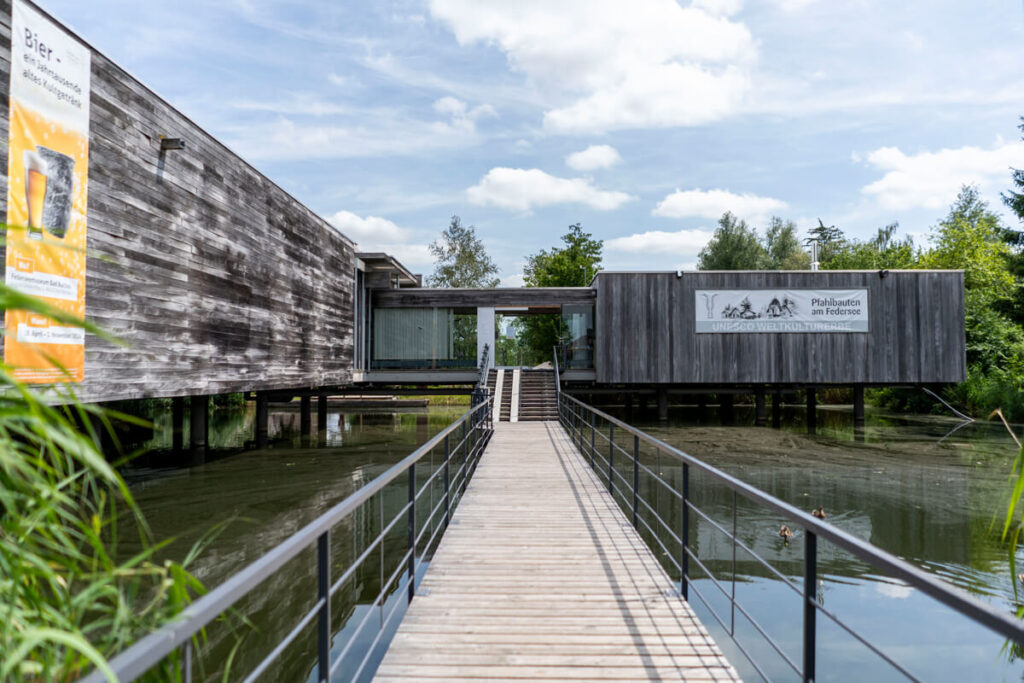
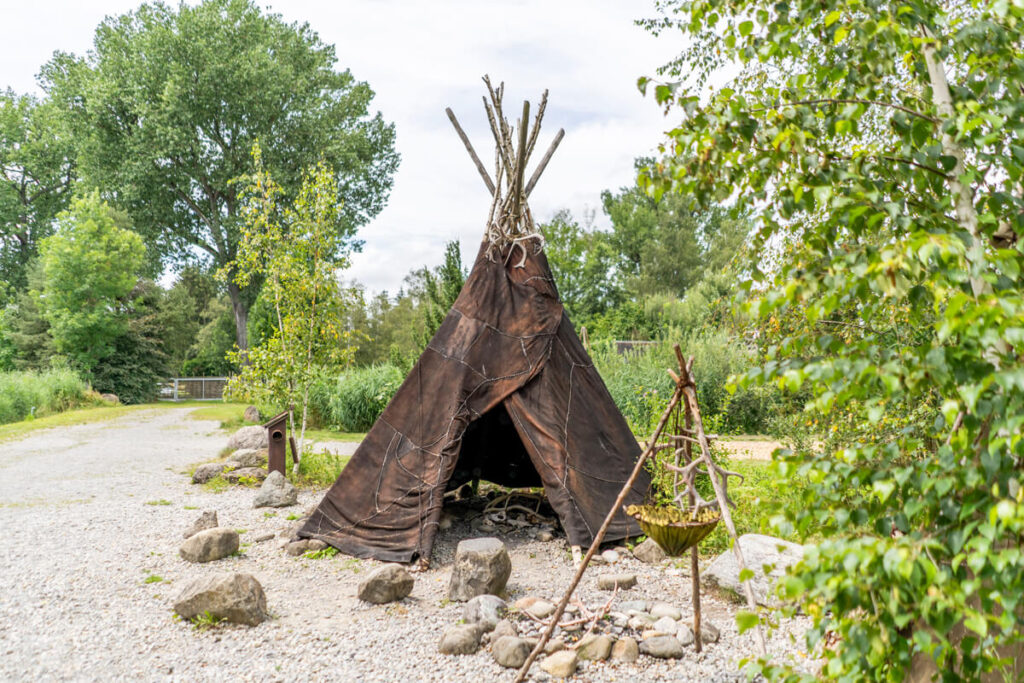
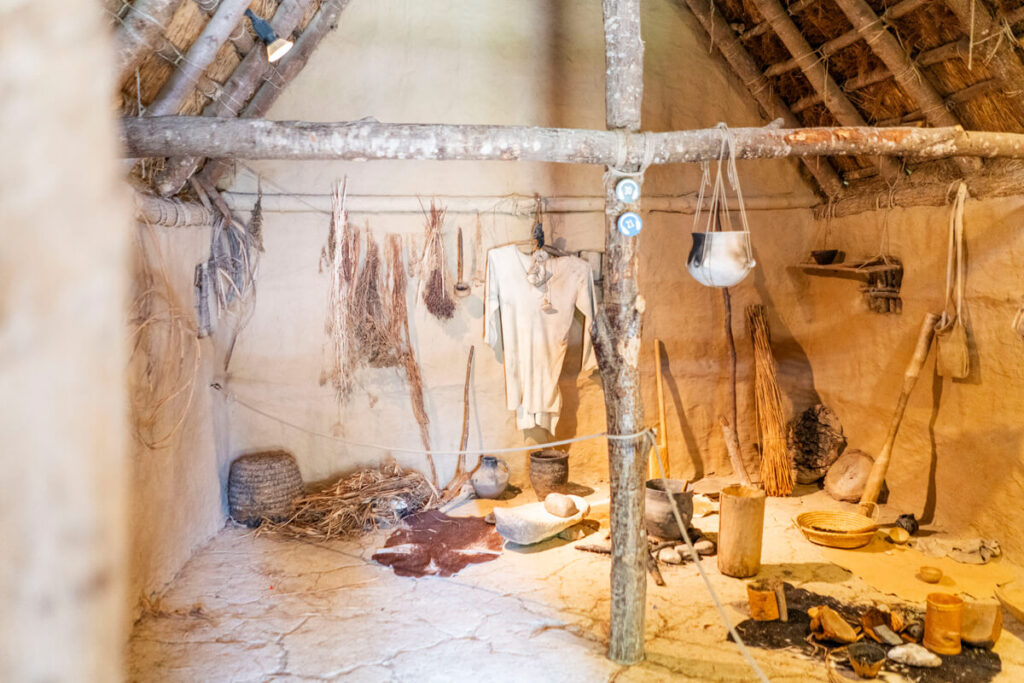
7. The Monastery Town of Bad Schussenried
For a short stopover, we recommend a detour to Bad Schussenried. The small town of Bad Schussenried is primarily known for its monastery, which represents an important cultural and historical heritage of the region. Founded in 1183, the monastery is, so to speak, the heart of the town.
It was redesigned in the Baroque style and now houses a museum and a library with a magnificent Rococo hall, one of the most beautiful in southern Germany. The library is famous for its impressive ceiling frescoes and stucco work, which symbolize knowledge and enlightenment. A must-visit!
Visitor information for Schussenried Monastery:
- Address: Klosterstraße 4, 88427 Bad Schussenried
- Opening hours: Tue. – Fri. 10 a.m. to 1 p.m. & 2 p.m. to 5 p.m. | Sat., Sun. + Public Holidays 10 a.m. to 5 p.m.
- Admission prices: Adults €5.50, reduced €2.80
- Guided tours: see homepage
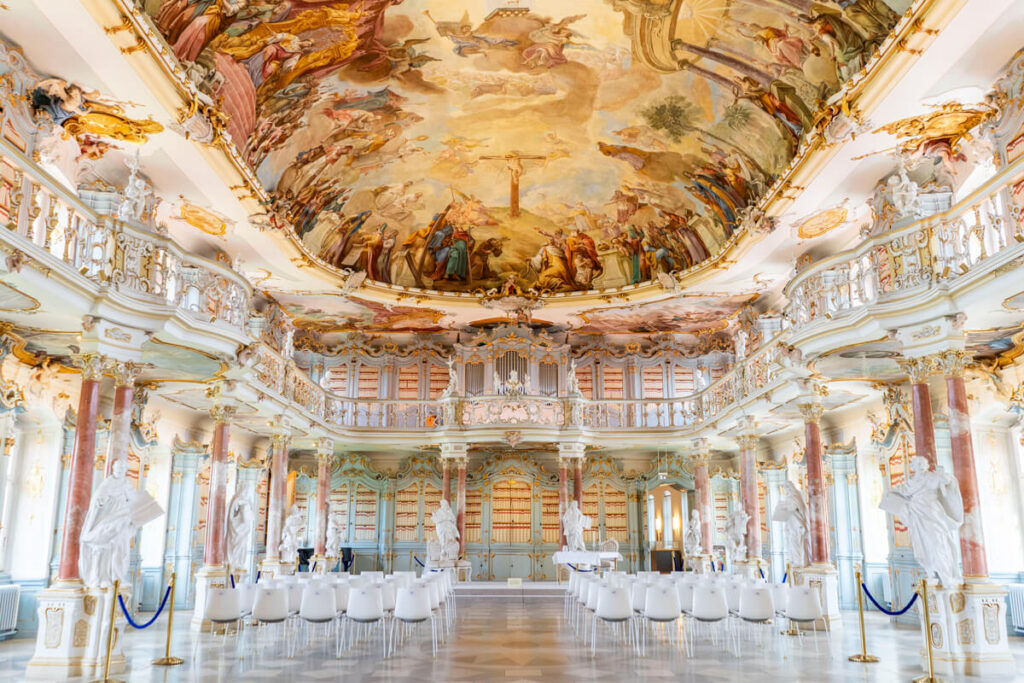
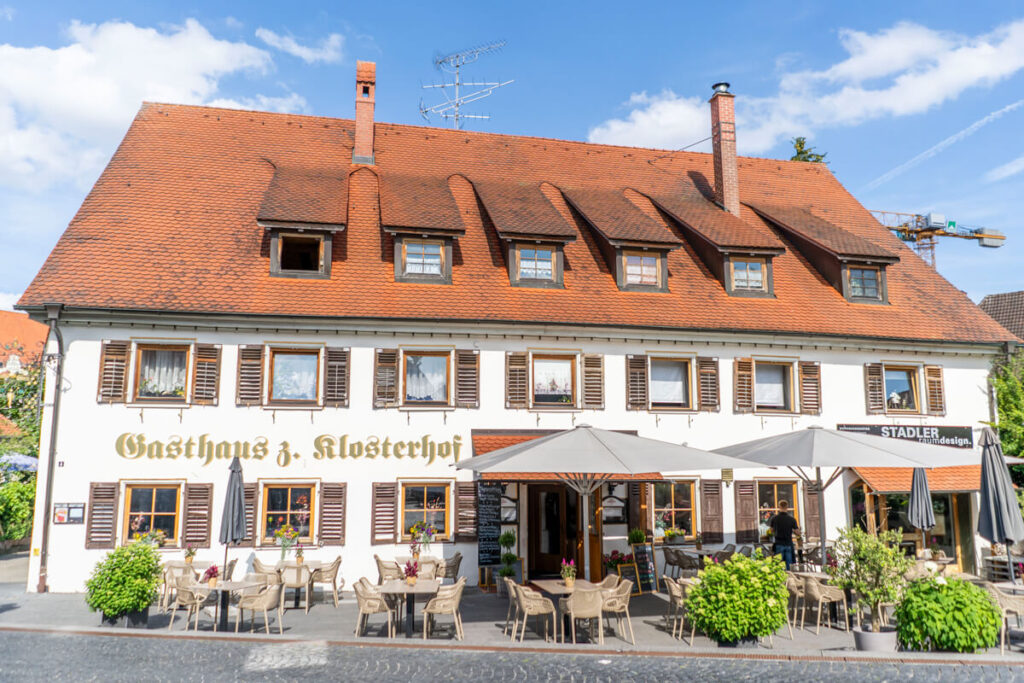
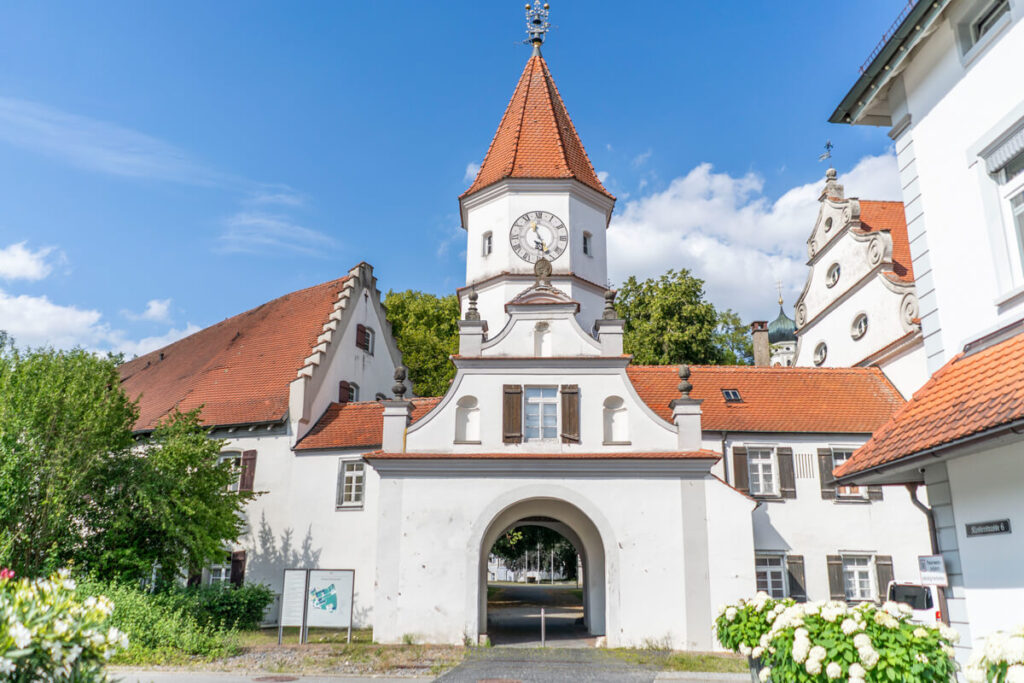
8. The Eye-Catcher Biberach
Another highlight of our tour through Upper Swabia-Allgäu was the town of Biberach an der Riß. This town is known for its very well-preserved old town with picturesque half-timbered houses, winding alleys, and the market square as its center. Among the highlights of Biberach are the Old and New Town Halls, the parish church of St. Martin, the White Tower, the Weberberg, the huge market square, and the various viewpoints.
When walking through the town, we also recommend the short climb towards the White Tower. From there, you have a fantastic view over the rooftops of the town (especially from the “Schillerhöhe”). If you take a guided tour, you can climb the Gigelturm and enjoy a 360-degree view. You’ll also learn a lot of interesting facts about the city.



Just above the old town is the Weberberggasse with its numerous half-timbered houses dating back to the 14th century. The former weavers’ guild settlement is also a stop on the popular German Half-Timbered House Route. Stroll through the winding streets and marvel at the truly worth-seeing and beautifully restored houses.
The town is also known for its festivals and events. The Biberach Marksmen’s Festival is particularly popular and widely celebrated. This is a traditional children’s and local festival that takes place every year in July for 10 consecutive days. Numerous parades and festivals take place throughout the town during this time. More about this here: Biberach Shooting Festival.
Our food tips for Biberach:
- stadt:cafe Biberach
- Pocissimo Coffee
- Schimpanski CafeDeli
- Grüne Pause
- Restaurant Schwarzer Adler
- Eisparlor Pra
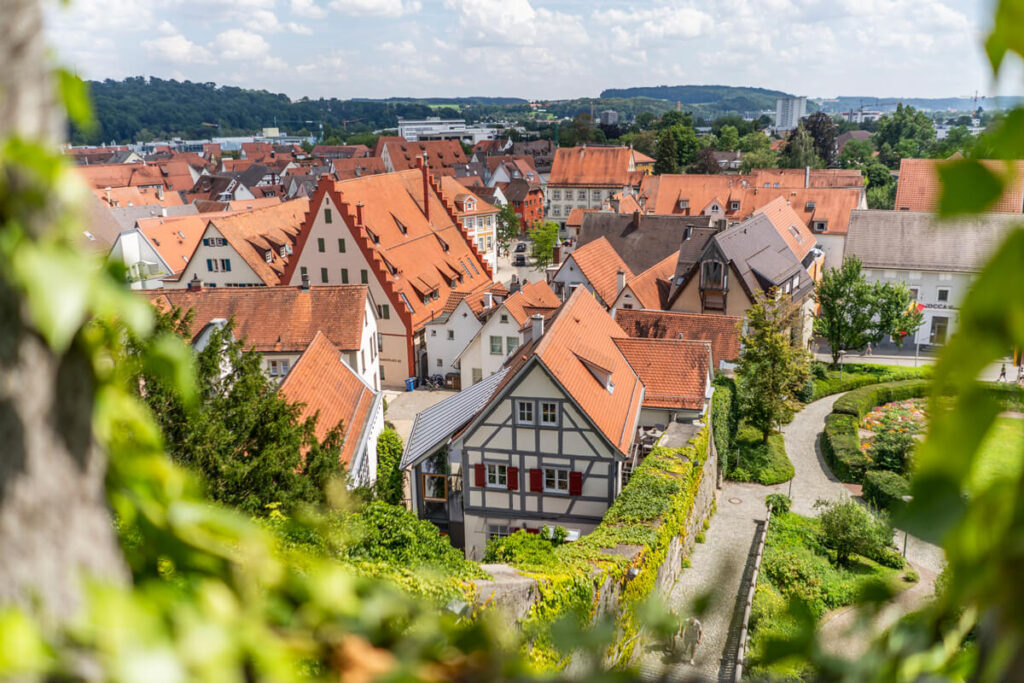
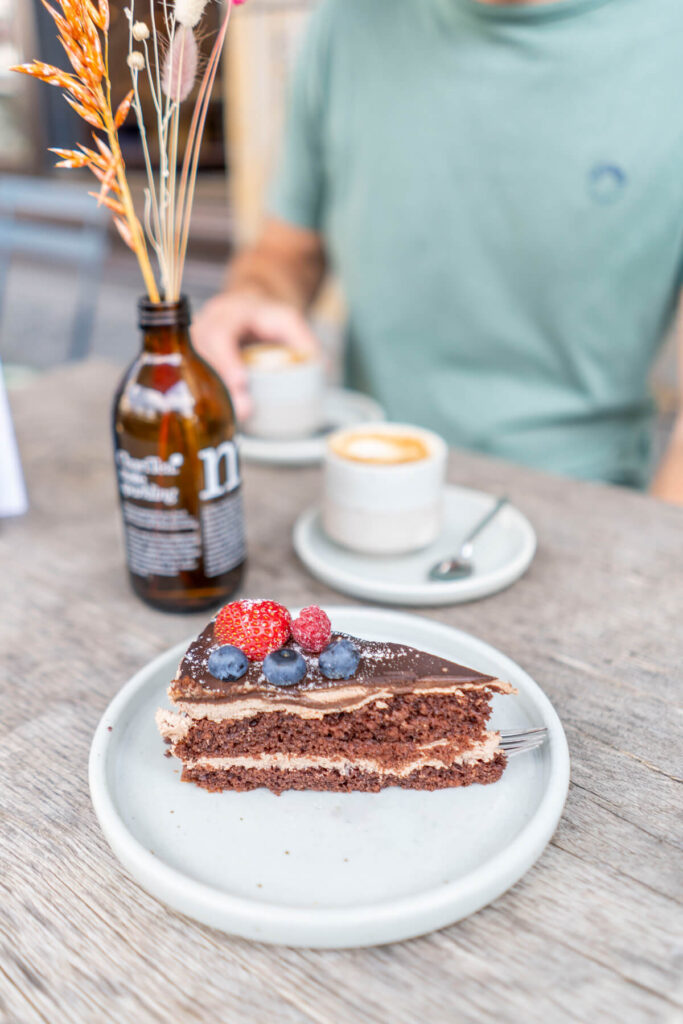
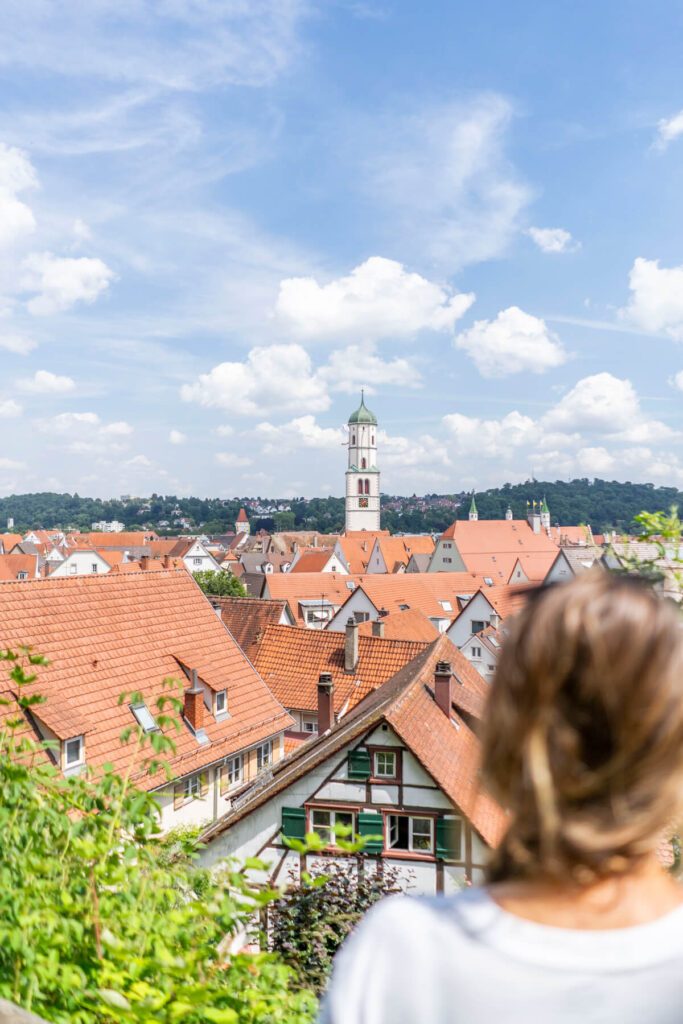
9. Sigmaringen & Hohenzollern Castle
Our last stop was in the town of Sigmaringen, which is especially known for its impressive and worth seeing Hohenzollern Castle. The castle towers majestically above the town and the Danube and is one of the largest and most important castles in Baden-Württemberg. The Hohenzollern family still has its residence and administrative headquarters here today.
For a great first view of the castle, we recommend a detour to the “Viewpoint on the Mühlberg”. Afterwards, you should also take a look inside the castle. You can explore the magnificent rooms on your own with an audio guide or take part in a guided tour. The weapons collection, one of the largest private collections in Europe, is particularly impressive.
Visitor information Sigmaringen Castle:
- Address: Karl-Anton-Platz 8, 72488 Sigmaringen
- Opening hours: vary depending on the month ––> see castle opening hours
- Admission prices: Adults 16 €, reduced 13 €, children 7 €, family ticket from 25 €
- Guided tours: always at 10 a.m., 12 p.m., 2 p.m. and 4 p.m.

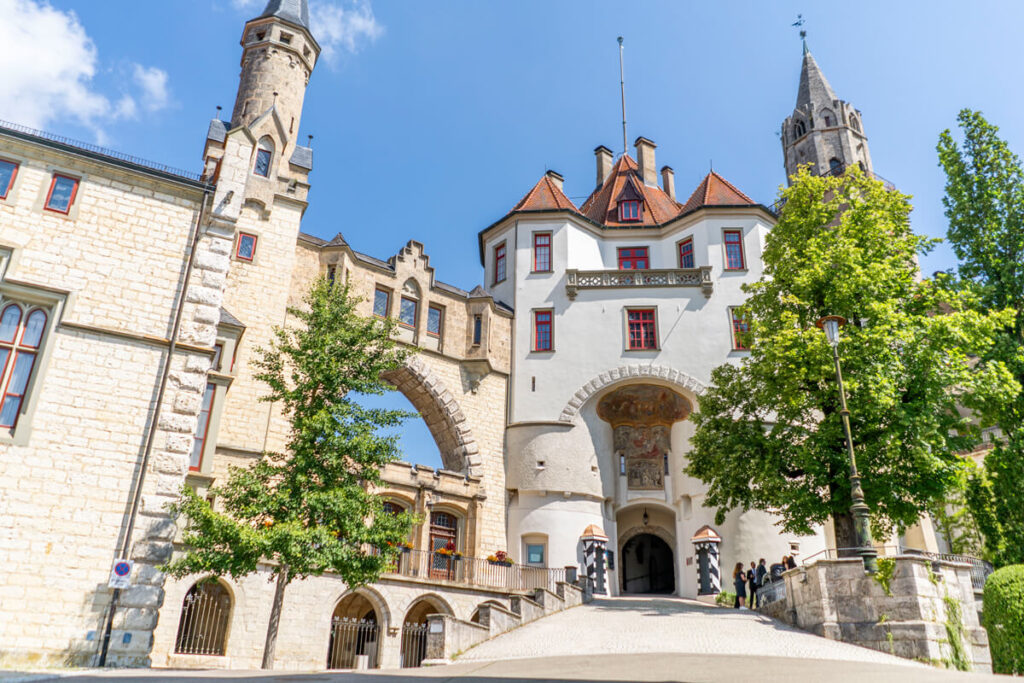
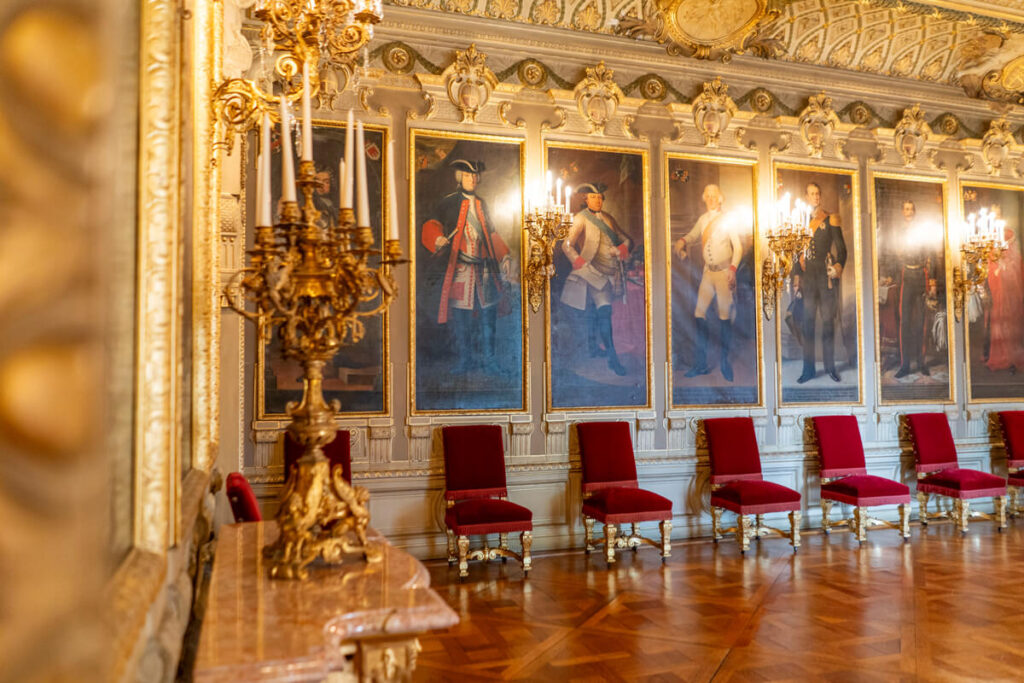
The old town of Sigmaringen is characterized by historic buildings, narrow alleys, and squares that preserve the charm of bygone times. You don’t need a car, as the routes are short and easily accessible on foot. We also recommend a coffee break at Hotel Karls, with its fantastic view of Sigmaringen Castle from the terrace.
Sigmaringen is also an ideal starting point for excursions to the Upper Danube Nature Park, which impresses with its spectacular rock formations, castles, and hiking trails. The Danube cycle path also leads through the town and offers beautiful views of the countryside.
Our food tips for Sigmaringen:
- Hotel Karls (drinks on the terrace)
- Theatercafé (good salads & pasta)
- Quh – Burgers | Fries | Street Food
- Restaurant Brauwerk Zoller-Hof
- Ice Cream Parlor Dolomiti
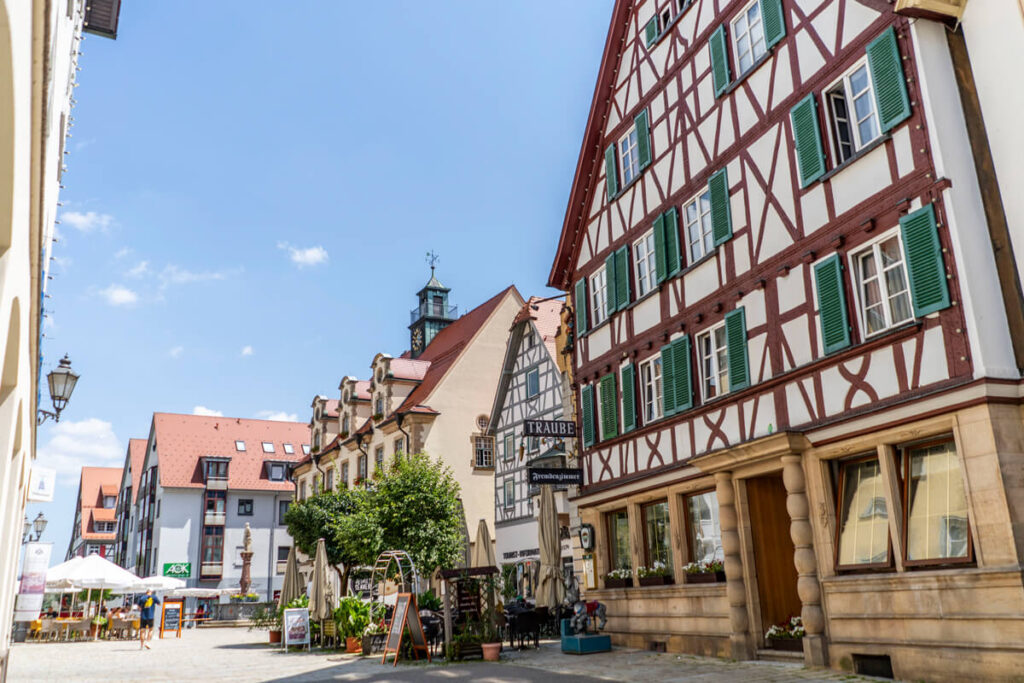
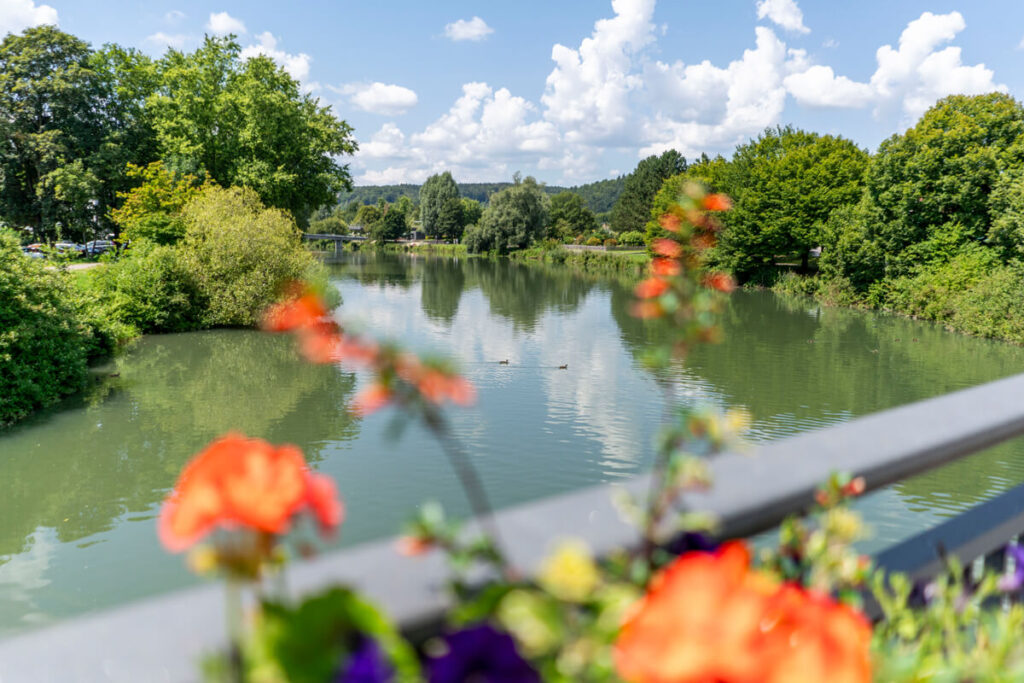
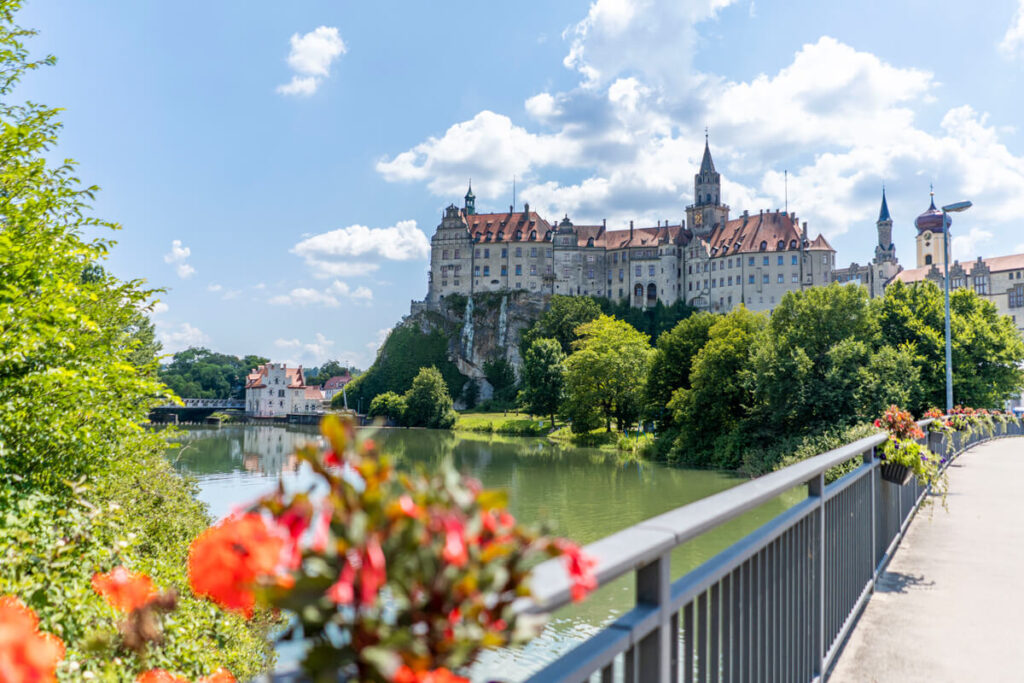
Our Hotel Tips
During our tour through Upper Swabia-Allgäu, we stayed in various accommodations. Below, we’ll introduce you to these accommodations in more detail and list a few other great hotels and guesthouses.
Obertor Hotel Ravensburg
The 3-star Hotel Obertor is located right next to the Obertor in Ravensburg and is therefore very centrally located at the beginning of the historic old town. Our room on the upper floor was very spacious and comfortably furnished. None of the lovingly furnished rooms are alike. A delicious breakfast buffet awaited us in the morning.
4 out of 5 points on Tripadvisor* | Book a room here*
Hotel Grüner Baum
The charming 3-star Hotel Grüner Baum is located in the heart of Bad Waldsee’s old town. The rooms are individually furnished and feature a bathroom with shower, TV, seating area, and Wi-Fi. You can order delicious dishes in the adjoining restaurant and end the evening on the terrace.
8.1 out of 10 points on Booking.com* | Book a room here*
Landgasthof zur Linde
This small but fine country hotel in Steinhausen has 5 double rooms, 5 single rooms, and 2 family rooms. The rooms are very modern and furnished to a high standard and feature a bathroom with shower, balcony, or terrace. A small breakfast buffet is available in the morning.
4.5 out of 5 points on Tripadvisor* | Book a room here*
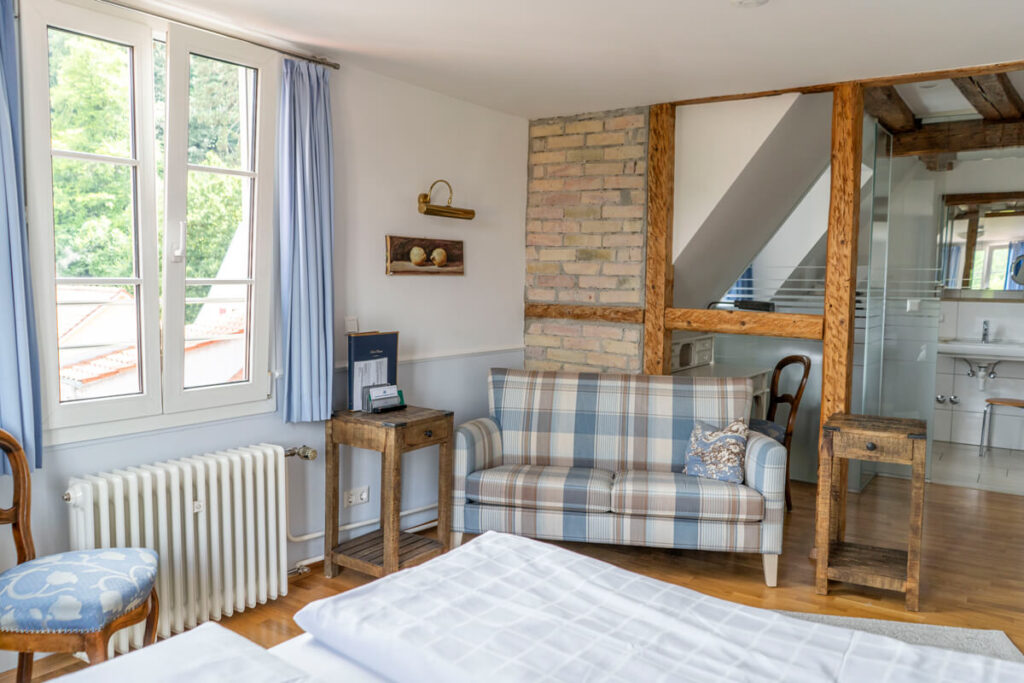
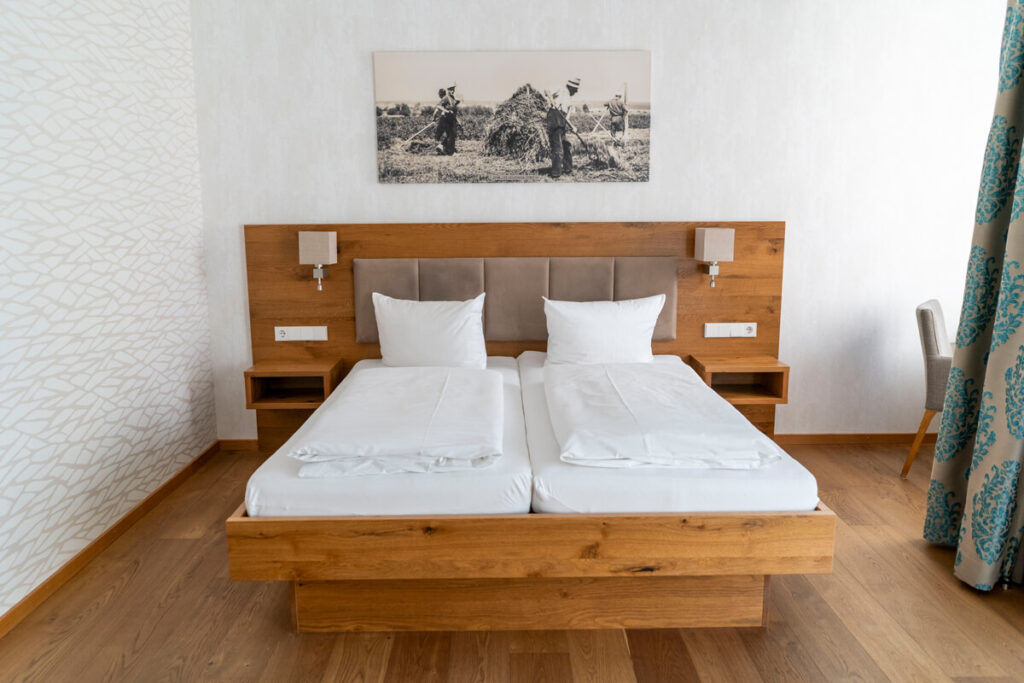
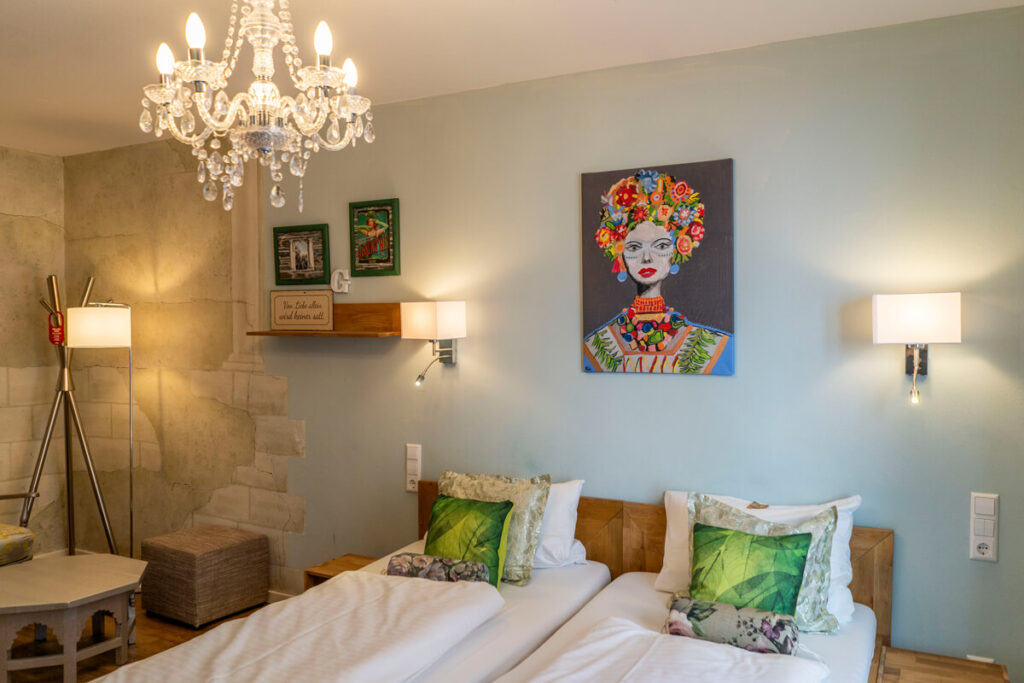
Other hotels in this region:
- Karls Hotel Sigmaringen*
- Thermenhotel Gesundheits-Bad Buchau*
- Parkhotel Jordanbad Biberach*
- Restaurant Residence Ente*
- Hotel Kaiserhof Ravensburg*
Conclusion of the tour through Upper Swabia-Allgäu
Our tour through the Upper Swabia-Allgäu region was truly diverse and exciting. The landscape in this region is simply impressive. From the rolling hills and meadows in Upper Swabia to the Alps in the Allgäu – there’s plenty of nature to discover here.
Cities like Ravensburg and Biberach are real eye-catchers with historic old towns and great sights. Castles like the Hohenzollern Castle in Sigmaringen are a must-see, and historic monasteries like Bad Schussenried Monastery are also incredibly interesting and worth seeing.
In general, Upper Swabia and the Allgäu region offer a great mix of nature, cuisine, history, and culture. There’s plenty to see and experience, whether you’re looking for adventure, want to enjoy culture, or just relax. Definitely worth a trip!